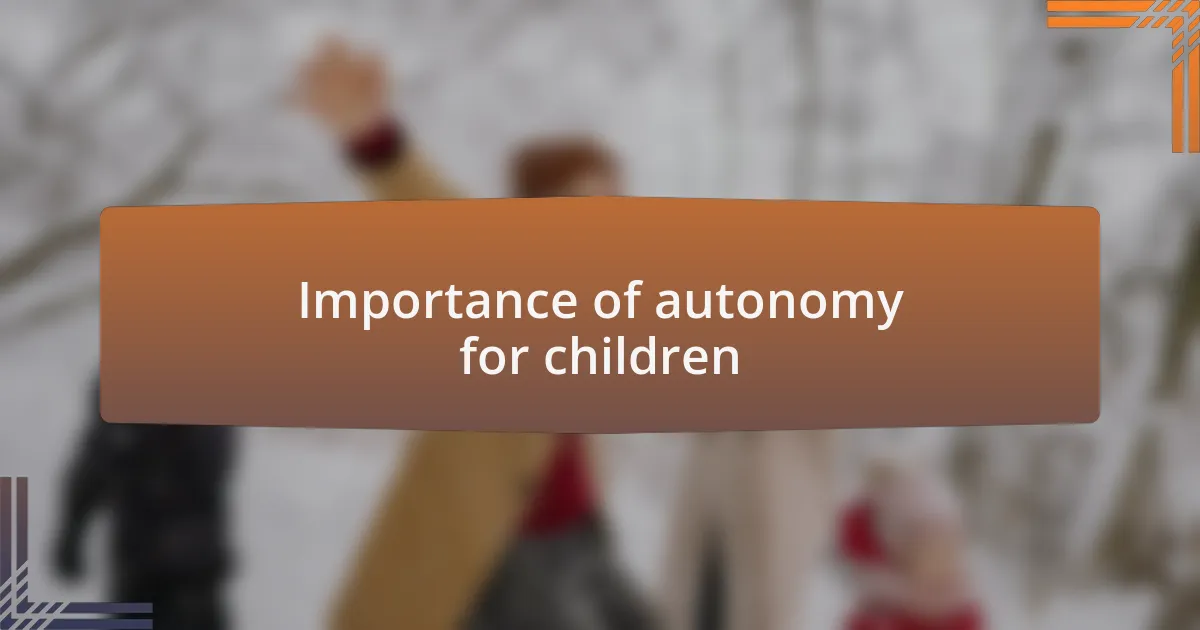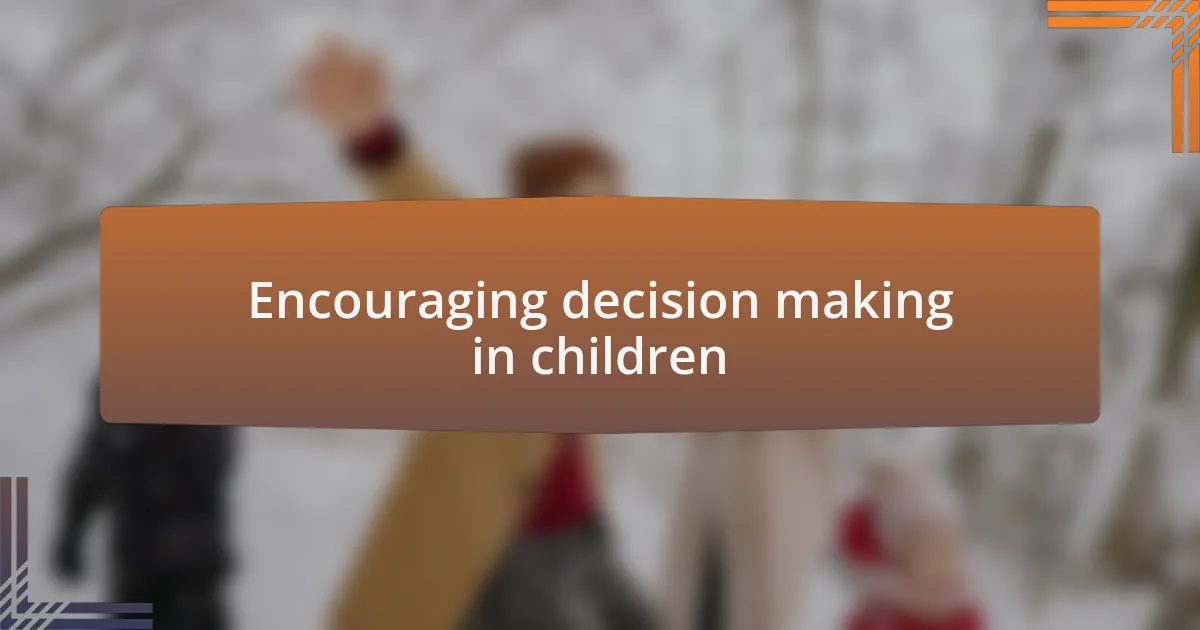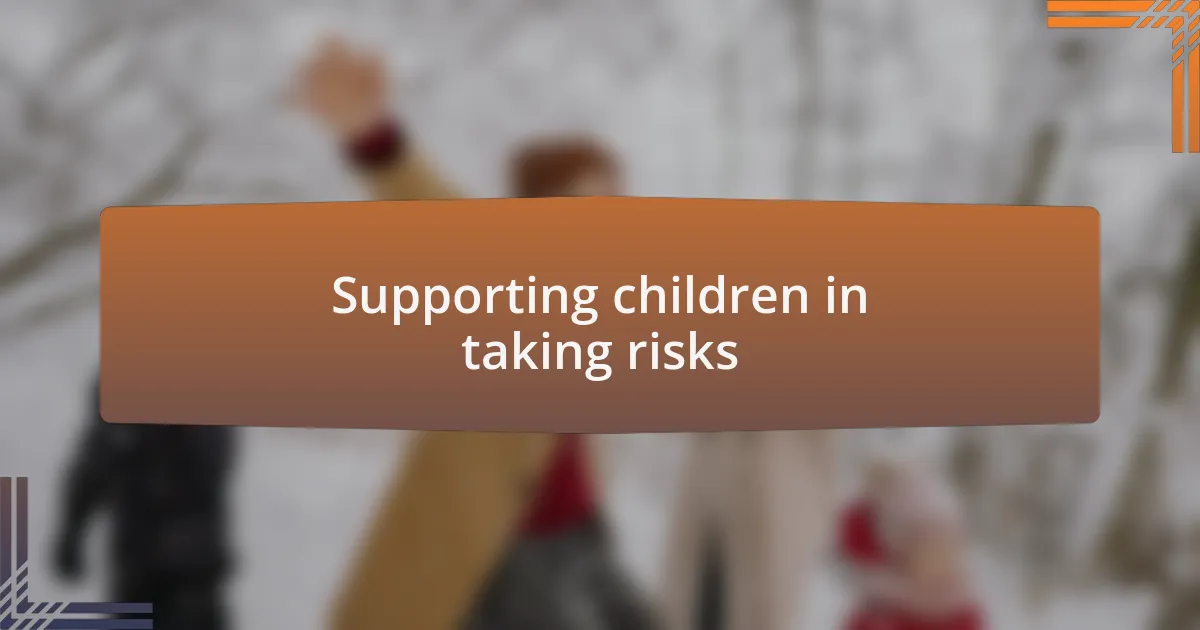Key takeaways:
- Children’s autonomy boosts confidence and helps them develop decision-making skills through small choices, like selecting clothes or weekend activities.
- Fostering autonomy nurtures resilience, enabling children to handle challenges independently and express their feelings in difficult situations.
- Encouraging decision-making by respecting children’s choices, even if unconventional, enhances their individuality and self-esteem.
- Supporting risk-taking in both physical and emotional contexts helps build confidence and prepares children for larger challenges in life.
Understanding children’s autonomy
Understanding children’s autonomy is a crucial aspect of their development. When my child first insisted on choosing their own clothes, I initially felt a pang of uncertainty. What if they picked something mismatched? However, I soon realized that allowing them that choice not only boosted their confidence but also gave them a sense of control over their own body and choices.
It’s fascinating how autonomy develops through little decisions. I remember a time when my child wanted to help plan our weekend activities. This experience not only taught them valuable decision-making skills, but it also demonstrated how empowering it can be to have a voice. Have you ever considered how even small moments like this can shape your child’s self-esteem and independence?
The journey of understanding autonomy isn’t just about decision-making; it also involves respecting boundaries and encouraging dialogue. I often ask my children about their thoughts and feelings, creating an open space for communication. This approach transforms our relationship into a partnership, where they feel heard and valued. How do you foster autonomy in your child while ensuring they understand the responsibilities that come with it?

Importance of autonomy for children
Respecting and fostering a child’s autonomy is essential because it lays the foundation for their self-confidence. I recall a time when my daughter decided she wanted to pick out a new hobby. While I initially had my own ideas, I realized that allowing her to explore her interests helped her discover her passions. It was incredible to witness her enthusiasm as she chose art classes, ultimately leading to so much personal satisfaction for her.
Moreover, children who experience autonomy often develop problem-solving skills early on. One day, my son faced a challenge with his homework and asked for my help. Instead of providing the answers, I encouraged him to think through the problem. I could see the gears turning in his mind; he ultimately came up with a solution himself. That moment made me appreciate how much kids grow when they know they can tackle challenges independently.
It’s clear that autonomy nurtures resilience in children. I often think about an incident where my child faced disappointment when a friend canceled playdates. Instead of intervening immediately, I let them navigate their emotions. They learned to express their feelings and ultimately found new ways to connect with friends. Have you ever stepped back and allowed your child to work through their emotions? It’s a beautiful and transformative process for both of you.

Strategies for promoting autonomy
One effective strategy for promoting autonomy is to create a safe space for decision-making. I remember when my child had the chance to choose their bedtime reading material. Instead of guiding them toward what I thought was appropriate, I allowed them to select any book they liked. Watching them embrace that freedom sparked a newfound joy in reading, and I was amazed at how quickly they began to develop their preferences. Have you ever noticed how empowering it can be for children when you step back and let them lead?
Encouraging self-advocacy is another vital aspect of fostering autonomy. There was an instance when my child felt overwhelmed during a group project at school. Instead of intervening directly, I prompted them to speak up about their feelings. The act of expressing their needs transformed how they interacted with peers, giving them a voice in their collaborative efforts. By enabling them to advocate for themselves, I could see the pride they felt when things began to change for the better. Isn’t it rewarding to witness your child take charge of their experiences?
Offering opportunities for practical life skills is crucial too. I fondly recall a weekend when we decided to cook dinner together. Initially, I thought about taking control of the kitchen, but I chose to let my child lead the cooking process. They measured ingredients, followed the recipe, and even suggested a twist to the dish. The joy on their face as we shared a meal they created themselves was priceless! Could there be a better way to help children develop independence than by involving them in everyday tasks? It seems small, but each experience adds to their confidence and ability to navigate the world.

Encouraging decision making in children
Encouraging decision-making in children starts with allowing them to express their preferences. I recall a day at the park when my child insisted on choosing which playground equipment to use first. Instead of nudging them towards the swings, I simply followed their lead. Seeing their excitement as they navigated their choices made me realize how essential it is for them to explore their desires and interests. Isn’t it fascinating how children thrive when they feel their opinions matter?
Another memorable experience was when I allowed my child to decide how to spend their Saturday. They opted for a nature scavenger hunt, complete with a list of items to find. Watching them strategize and come up with ideas filled me with pride. I couldn’t help but marvel at their ability to plan and execute a fun adventure all on their own. Isn’t it wonderful to see children take initiative and discover the joy of making their own choices?
Encouraging children to make decisions also means respecting the choices they make, even when we might not agree with them. Once, my child chose to wear mismatched socks for their school presentation. Initially, I hesitated, worried about how others would perceive them. But I decided to support their choice wholeheartedly. The beaming smile they wore during the day reminded me that confidence often flourishes when we embrace our individuality. How could we not celebrate these unique expressions of self, even if they seem unconventional?

Supporting children in taking risks
As children learn to navigate their world, taking risks becomes an essential part of their growth. I remember a camping trip where my child wanted to climb a tree. At first, I felt that familiar surge of anxiety, envisioning possible falls. But after a moment’s pause, I realized that allowing this little adventure was crucial for their confidence. Seeing them reach that first branch, feeling the excitement of being up high—it was a beautiful reminder that sometimes, stepping back can let children step up.
There was also a time when my child wanted to ride their bicycle without training wheels for the first time. I stood nearby, ready to catch them if necessary, but I could tell they needed to take that leap on their own. When they finally found their balance and pedaled away, the joy on their face was indescribable. Watching them take this risk and succeed reinforced for me how vital it is to let our children test their limits. Isn’t it amazing how these small moments of bravery can build a foundation for greater challenges ahead?
Support in risk-taking isn’t just about physical challenges; it’s also about emotional ones. I recall the day my child stood up to a friend during a disagreement, a moment where they had to voice their feelings rather than simply conform. My heart swelled with pride as I watched. In those instances, we show our children that stepping out of their comfort zone can foster resilience and self-assurance. How often do we reflect on the importance of these emotional risks in shaping their character?